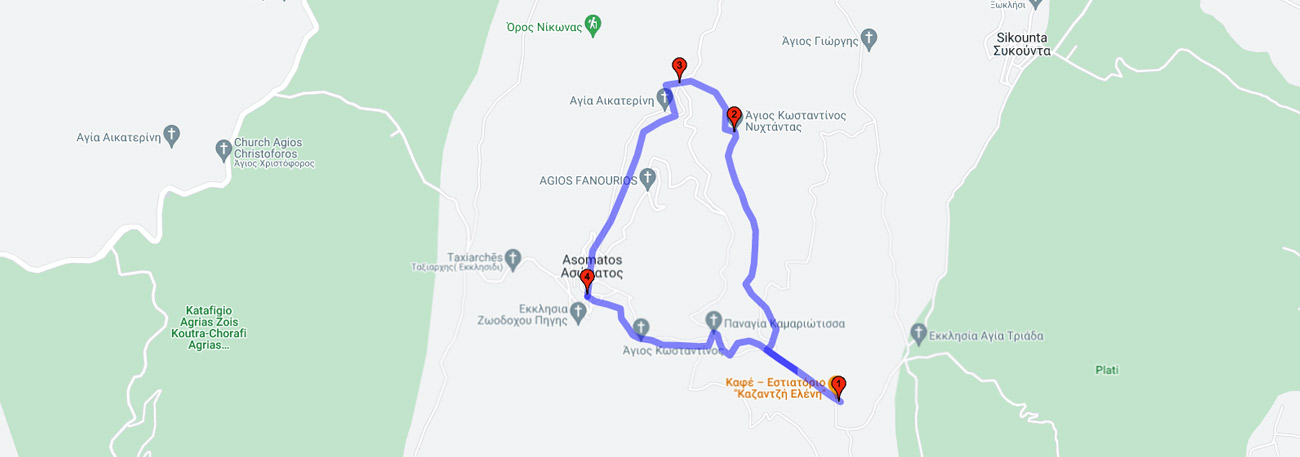Agioi Anargyroi - Agioi Konstantinos and Eleni - Nychtanta - Asomatos

| General description: |
Hiking trail through rural landscapes and forested areas with pine trees, cultivated olive groves, fir trees, and orchids. |
| Detail description: |
Moving north along the path from Agioi Anargyroi, the route crosses the Andriotis river and moves parallel and slightly higher up in the olive grove. After the chapel of Saints Constantine and Helen, it reaches Nychtanta, where there was a settlement of Ottomans. Few houses and the bathhouse are preserved. On the asphalt, there is the old hydro-powered olive oil press, where the path intersects with the hiking trail Agiasos - Asomatos - Karini. Our route leads directly to Asomatos, through a traditional stone-paved path. The village stands high among the olive groves, clean and traditional, with stone houses, cobbled streets, and hospitable residents. |
| Transportation means: |
Car to Agioi Anargyroi and bus to Asomatos, you can take th route in reverse. |
| Accessibility: |
Asphalt access to Asomatos, Agioi Anargyroi, Nychtanta |
| Best season: |
Annually |
| Places to visit: |
Water mill and outdoor olive press in the area of Agioi Anargyri, the picturesque settlement of Asomatos |
| Signage: |
Yes |
| Route starting point: |
Agioi Anargyroi (Asomatos Alternatives for ease of access) |
| End of Route: |
Asomatos (Alternatively Agioi Anargyroi for ease of access) |
| Type of tourism: |
Nature-loving, walking/hiking, cultural |
Points of interest
Agioi Anargyroi
| Name: |
Agioi Anargyroi |
| Description: |
Settlement |
| Category: |
Cultural element |
| Longitude: |
39,096414 |
| Latitude: |
26,401309 |
| Altitude: |
159 |
The Agioi Anargyroi is an area of unparalleled natural beauty, known for its lush greenery and running waters, which give it a magical aura. A captivating destination that attracts visitors to wander along the river banks, enjoy the atmosphere, and spend some peaceful moments in the shady, verdant environment. Agioi Anargyroi is full of plane trees, chestnut trees, cherry trees, and sour cherry trees, whose leaves turn from green to vivid red during the summer months. The 80-year-old olive press is fully functional, and seeing it in operation will give you a first-hand experience of the traditional methods used to extract olive oil. You can also get a taste of freshly baked bread drizzled with olive oil, a traditional Lesvos delicacy.
Nychtanta
| Name: |
Nychtanta |
| Description: |
Old industrial buildings |
| Category: |
Cultural element |
| Longitude: |
39,109335 |
| Latitude: |
26,393922 |
| Altitude: |
95 |
Here was the small village of Nyhtanta, where in 1909 one of the 5 water-powered olive presses on the island was in operation! A unique system of metal pipes, supported by masonry, rectangular columns, the aqueduct, started from a metal tank that was filled from a millpond with the ties of the river, higher up. Then it was converted to steam-powered with three compressors. The settlement had a few houses, the Baths, the spring, the valley of the river with the watermills, the olive grove, and the "patomeni" with Agia Katerina further up, which climbed up to Agiasos, located in the beautiful stream, with the plane trees, under the limestone massif of Nikonas. The waters from the springs keep the river flowing continuously.
Agioi Konstantinos and Eleni
| Name: |
Agioi Konstantinos and Eleni |
| Description: |
Church/Monastery |
| Category: |
Cultural element |
| Longitude: |
39,098648 |
| Latitude: |
26,391851 |
| Altitude: |
260 |
The chapel is next to the river, amidst dense vegetation and serves as a rest stop along the way.
Asomatos
| Name: |
Asomatos |
| Description: |
Settlement |
| Category: |
Cultural element |
| Longitude: |
39,101363 |
| Latitude: |
26,389044 |
| Altitude: |
267 |
A mountain village with a plethora of legends and local traditions, Asomatos, is built next to the rocky mass of "Nikonas". At the entrance of the village, we find the school in a beautiful building. Continuing, we come across the market with cafes, bakeries - with the famous paximadia - and other shops. There are two olive presses and a flour mill. Walking along the cobbled streets, the visitor can admire the stone houses, the beautiful marble fountains, the picturesque cafes with the vines, the devout chapels, and generally an atmosphere that is genuine and at the same time different from that of the bustling city with its frantic pace.
The route
